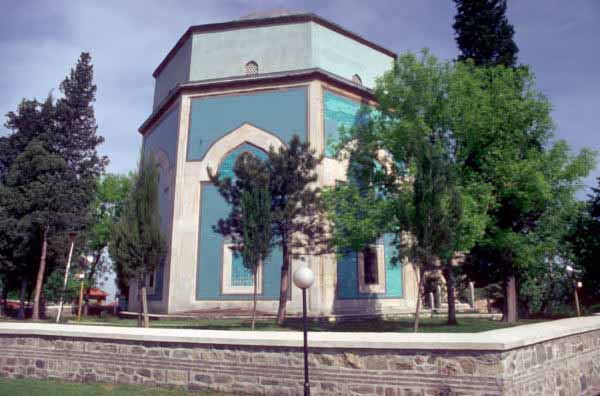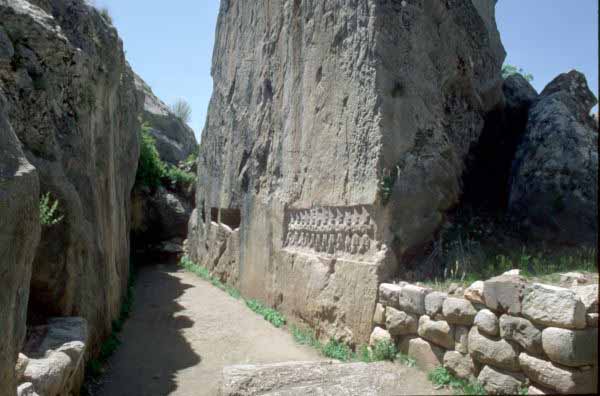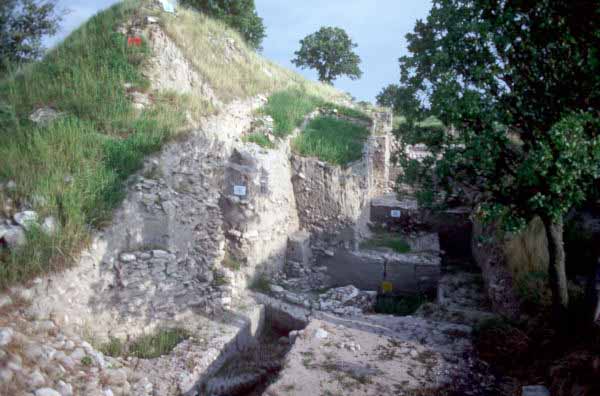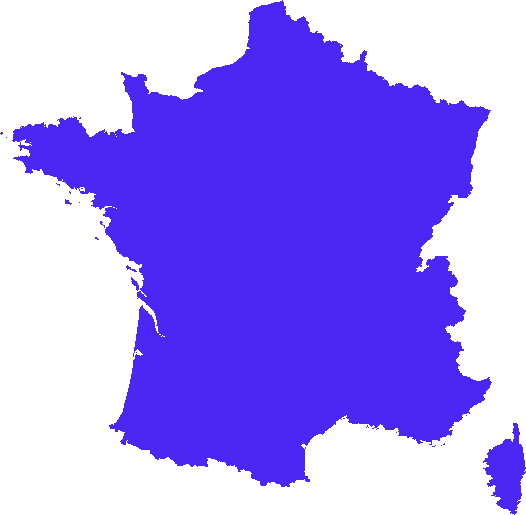|
|
 |
Turkey,
from Hittites to Ottomans |
|
The journey to Turkey was a package tour. It was part
of a programme of visits to central Asia to discover the Turco-Moslem
world.
The group was composed of 20 people. A French guide,
a specialist in Central Asia, accompanied us.
The trip was made in 1994, from May 01 to May 15.
After an Air France flight, the arrival in Istanbul was on time.
The report is in six tables. The general comments are given by the
Turkey presentation. |
|
|
|
|
Istanbul |
|
|
|
 |
|
Sultan Ahmet Camii |
 |
|
Sancta Sophia |
 |
|
Yerabatan-Sarayi |
 |
|
Kahriye Camii |
|
|
Approach: The Air France flight lasted nearly 3 hours from Paris
to Istanbul. It took off at 11:30 am from Paris and arrived at 2:30 pm
(Paris time) at the international airport of Istanbul.
It is
foolish to write an abstract of a trip to Turkey since so many monuments are to
be seen and re-examine. On a purely informative basis, the "Guide
Bleu" of Turkey devotes more than one hundred pages to Istanbul!
Istanbul, which means the city in Arabic, is a link between the
West and the East. In turn, Byzantium,
Constantinople, Stamboul, Istanbul, it is full of architectural
wonders of its prestigious old days. The list of the monuments
I visited is long, only the most attractive are mentioned.
The hippodrome, or what it left of it, was the main
place of popular festivals and political meetings of former
Constantinople. Its site, 400m long on 150m wide, is occupied by
monuments of the Ottoman time:
The museum of arts is in the old palace of Ibrahim Pasa.
The collections are ethnographic and cover the Seldjukide period.
The Fountain of William II, the column of Constantine, the
column of Theodose, the serpentine column are located on what was
the central part of the Hippodrome.
The Blue mosque, Sultan Ahmet Camii, owes its name to the
colour of its earthenware. Built in 1609-1616, it was the work of
Mehmet Aga the architect.
Sancta Sophia is the former basilica of Constantinople
reconverted to Islam. Some mosaics and paintings were
ransacked. It burned several times, then the cupola was destroyed by a
seism, the current building dates back to Justinian, 532.
The Basilica cistern, Yerabatan-Sarnici, is a former Byzantine
cistern consisting of 336 columns made up of shafts
from ancient monuments, of heads upside down, sideways, on the wrong side,
an incredible spectacle accompanied by sound and light show.
The Topkapi palace is undoubtedly the jewel of Istanbul.
The furniture, the earthenware are an enchantment the eyes and the
visit of the Harem raises fantasies.
The Saint Serge and Saint Bacchus church has a cupola
supported by an octagonal base. The monogram of Justinian and
Theodora is reproduced on some pillars.
The Süleymaniye mosque is regarded as the masterpiece of architect
Sinan. Built from 1550 to 1557, it is preceded by a
yard construct with columns from the ex-hippodrome and beside the
tombs of Suleyman and of his favourite wife Roxelane can be seen.
he Porphyrogénète palace was the residence of the Byzantine
emperors until the fall of the empire. only a wall with elegant
windows is left.
Saint-Sauveur in Chora, Kahriye Camii, dates back to the 11th
century. It has the most beautiful mosaics with golden background and
the most prestigious paintings of the Byzantine World. |
|
|
|
|
|
The visit of Istanbul was a race against the clock, I visited only
one tenth of the city monuments.
The Ottoman mosque is characterized by its architectural continuity with
Byzantine art, as shows Aya Sofya which was used as a
model for the Blue and Süleymaniye mosques. It is characterized by
elegant cupolas and sumptuous mosaics. Ottoman architects knew how to use
the knowledge of Byzantine craftsmen.
The panorama on the Bosporus from the Serail point of the Gold Horn is
dramatic at sunset.
|
|
|
|
|
Bursa, Ankara, Bogâzköy |
|
|
|
|
Approach: After crossing the Bosporus to go to
Asia Minor, we took the ferry-boat from Tuzla to Yalova to go to Bursa
on an excellent road.
Bursa: The city was the first capital of the Ottoman empire
after being besieged for more than twenty years. Seen from
the Ulu Dag hill, the city is dedicated to the green colour of its mosque
and its green trees.
The Muradiye mosque was built under Murat II, 1424-1427. It
has mosaics with floral and geometrical decoration on the tympanums of
the portal and the windows.
The mausoleums of Murat II and Cem are located in the
enclosure of the Muradiye cemetery.
The türbe of Orhan and Osman were rebuilt in the 19th century
in the style of the end of the empire. From the Terrace, the panorama
on the city is splendid.
The green mosque is spiked with minaret. It is built out of
marble and the prayer room is covered with green earthenware tiles.
The türbe of Mehmet Ist is the wonder of Bursa. It is an
octagon covered with enamelled earthenware of a bluish green.
The road from Bursa to Ankara, 385Km long, is superb. 300Km away from
Bursa, the site of Gordion, is historical by the
sword blow Alexander the Great gave to cut the famous Gordian knot.
The detour, a loop of a few kilometres from the main road, is
justified by a Phrygian king's tumulus whose access was made by a
tunnel dug by archaeologists. The funeral room is surrounded by a
wall in cedar or pine logs. The burial furniture is exhibited in a
small contiguous museum.
Ankara: The arrival at the hotel was late. The city is dual:
modern it was built by Atatürk, old it dates back to the Hittite time.
The museum of Anatolian civilizations: It exhibits priceless
wonders, mother goddesses of the Hittite period, Phrygian jewels,
Egyptian jewels and artefacts of Indo-European civilizations.
The citadel: Two walls were built at different Byzantine
times. The current building dates back to 797 after the unsuccessful
siege by Haroun Al-Rachid.
The mosque, Arslanhane camii, built in the 13th century
with use of elements from Greco-Roman temples. The result is strange.
The August temple: In turn, it was a Roman temple, a Christian
church then a mosque to finish its career as a historic building. Its
attraction comes from an inscription giving the assessment of the reign
of August! The mentality of political leaders has not changed!
The Atatürk's mausoleum: It cannot be compared to the monuments of
popular republics. Atatürk is considered in Turkey as the
father of the Turkish people. He liberated the territory from
foreign dominations and got his country into the modern world.
The visit of the city on foot showed all the ambivalence of this
capital divided between past and present. This could be experienced
from the citadel with the panorama of the city.
Bogâzköy: The trip to reach the former Hittite capital, Hattusa,
took 3 hours and a half a very beautiful sunny day.
The Hittites, Indo-European people, founded a powerful empire which dared to
challenge Pharaoh in particular at the famous battle of Qadesh
with light combat tanks.
Huttusa: The former capital has fortifications with impressive
gates and a gigantic temple dedicated to the god of storms and to goddess Arinna.
Yazilikaya: The site is an extraordinary rupestral sanctuary
dedicated to the divinities of the Hittite Pantheon. The walls of the
access by a defile between rocks leading to the temple preceded
by propylaia are carved by low reliefs representing the divinities.
The Hittite empire disappeared under the attacks from Assyrians as well as
from invaders that the Egyptians called "Sea people". |
|
 |
|
Türbe of Mehmet
|
 |
|
Gordion
|
 |
|
Atatürk's mausoleum
|
 |
|
Yazilikaya |
|
|
|
|
|
|
The trip from Hattusa, the capital of Hittites, to Ankara, the capital of modern Turkey,
with a stopover in Bursa, the capital of Ottomans was a jump over 5000 years of history.
It makes one dizzy at the thought of what humanity will be in five thousand years.
|
|
|
|
|
Cappadocia |
|
|
|
 |
|
Cappadocia |
 |
|
Fresco |
 |
|
Refectory |
 |
|
Underground city |
|
|
Approach: The trip from Bogâzköy to Avanos passed without transition
from the Anatolian plateau to Cappadocia, a geological curiosity. At the time
of the formation of the Taurus Mounts, volcanos appeared in the faults
rejecting soft materials which buried the vegetation. Then wind erosion
and water streaming made the Fairy Chimneys.
The Hattis occupied the area before the arrival of the Hittites in the 2d
millennium BC and disappeared with the invasions. Then Cappadocia knew a
boom with the domination of the Achaemenians and Seleucids. It was an
independent kingdom until the Byzantine empire and its conversion to
Christianity. After the arrival of the Turks and their victory at Mantkizet
in 1071, it became the part of the Sultanate of Rûm. Finally
in the 14th century, abandoned and without hierarchy, Christians
left the place to the progressive Islamization of the area and
deserted the former places of worship and dwelling.
Ürgüp: This town occupies several hills covered with houses
built of dry stones of various colours.
Uchisar: From the top of the piton, a dramatic panorama shows
by Cappadocia and the various geological structures. The visit of the
Peribacalari and Avcilar
valleys showed all the varieties of natural constructions.
The hidden church: Located in the El Nazar valley, it was
discovered in 1957. The flat ceiling is painted with a cross and
geometrical ornaments.
Avanos: This stage city is a typically Anatolian village where
potters perpetuate their ancestral tradition.
Göreme: The city has a museum in the open air, a set of Christian
buildings among the most beautiful dug in the geological structures of
soft tuff.
The St Basil chapel: The church is preceded by a narthex and
the main apse has exceptional paintings among which a Virgin with
the Child.
The Yilanli church: Called the church with the snakes, it
has paintings showing emperor Constantine and his mother.
The Ste Barb Church: It is built on cross plan. The motifs
are painted in red directly on the rock.
Storeroom, kitchen, refectory: These three constructions are
next to each other and communicating. The refectory could contain 40
and 50 people, it is of rectangular shape with walls unpainted
and stone tables and benches.
Tokali Kilise: It is the vastest of the set. The porch gives
access to the narthex then to the main nave. The paintings date back
to Nicephora Phocas (963-969).
The Cavusin Church: It has a single nave with a barrel vault
and three apses. The paintings of the vault represent the Escape to Egypt.
The church of the forty martyrs: It has two naves and two
apses. The frescos are rather well preserved, in particular the
Descent of Christ to Hell.
The underground cities, some of the cultural riches of Cappadocia, are
excavated in soft tuff. They sheltered the population in case of danger
Derinkuyu: The city is built 85m deep. It has all the city conveniences,
church, refectory, school, stable. A chimney ensures the ventilation.
Kaymakli: The houses are built in the neighbourhood of
hundreds of tunnels crossing the underground city. There are no
less than four levels of construction. |
|
|
|
|
|
Cappadocia deserves much more than one day of visit as the rupestral
churches are so numerous and the site is imposing by the grace of certain
geological structures. Long walks are possible in these hills gullied by
erosion.
|
|
|
|
|
Konya |
|
|
|
|
Approach: The trip, 240 Km long, was made on a very beautiful road
which made possible to admire the landscapes of the Anatolian plateau.
Agzikarahan: A large Seldjukide caravanserai located on the
previous Achaemenian royal road which connected Persia to Sardes.
Konya: Former Iconium was the capital of the sultanate of Rûm.
It is localised in the steppe. It was the Holy City of Sufism. Djalât Ad Dîn
Rûmi (1207-1273) was the founder of the sect known as that of the Dancing
Dervishes, due to their gyratory dance, the samâ.
The Alaedin Camii Mosque: Built in 1220, it was the work of a Damascus
architect under Seldjukids. The prayer room is equipped with Roman and Byzantine columns.
Tekke de Mevlâna: This attractive monument was the major place of
Moslem mysticism. It is the headlight of the city with its high tower
covered with green enamelled earthenware.
Büyük Karatay Medresesi: The medrese has a very beautiful
marble gate decorated with geometrical drawing and stalactites. It
shelters the museum of ceramics.
Ince Minare Medresesi: This former medrese shelters the museum of
wooden and stone sculpture.
Beysehir: The city is 92Km away from Konya. The Esrefoglu
mosque was built in 1298. The Imam being away, we could not visit it. |
|
 |
|
Agzikarahan |
 |
|
Mevlâna |
|
|
|
|
|
|
The city of Konya was a rapture, an oasis full of charm largely due
to few monuments to be seen, that can appear
contradictory, but the quality of those was an exceptional.
Moreover, it was very pleasant to stroll in the gardens of the city centre.
The rest of the trip was devoted to the Mediterranean and Aegean
coast to visit the ancient sites of the Roman world.
|
|
|
|
|
Antalaya, Pamukkale, Aphrodisias |
|
|
|
 |
|
Aspenos |
 |
|
Termessos |
 |
|
Hiérapolis |
 |
|
Aphrodisias |
|
|
Approach: The trip crossed over Taurus to reach the ancient sites.
On the way, we saw a Roman bridge restored at the time of Seldjukides. The
Mediterranean coast extends from Marmarisas as far as Antakya, ex Antiochus,
on the Syrian border. It is composed of three parts, the Lycian, Pamphylian
and Cilician coasts.
Pamphylia was one of the two Roman provinces. It extends
around the Antalaya gulf with Lycia in the east and Cilicia in the west.
Aspenos: The city is said to have been founded in the 2d century BC by
the inhabitants of Argos. it has the most beautiful theatre of the Roman world
built in 170 AD. It could contain twenty thousand people. It takes some of the
Greek layouts, the backing on a hillside. The Seldjukides added blue earthenware
to the decoration of the stage.
From the northern gate of the ancient city, there is a very beautiful sight on
an aqueduct dating back to the 2d century.
Perge: The site is one of the most evocative of ancient life with its theatre,
its stadium, its nymphea and its porticos road opened in its southern part by a
gate (3rd century BC).
Termessos:
The site is one of the most extraordinary be it visited in the
sun or on a foggy day, which was my case. The visit revealed the
wild beauty of the landscapes, the charm of its theatre against the
mountainside, the necropolis and the rupestral tombs. The site is
strewn with scattered vestiges which one does not know if they will
ever be restored.
The Meander valley with gathers several sites is a rich area
fertilized by the winding course of the Meander, Büyuk Menderes.
Hiérapolis: Pamukkale, the Cotton castle, is one of the
most spectacular natural phenomena in Turkey, a chalky cliff made of
terraced basins from which the water of the hot sources runs out in cascade.
The ancient cities was one of the Roman-world spa city. Patients flocked to be
cured. The excavation of the theatre revealed splendid reliefs of the 2d century
illustrating the myths of Dionysus, Apollo and Artemis. The necropolis out of
the ramparts is one of the largest of the Roman world.
Aphrodisias: The site is well known back to the bronze age, but
the city developed from the Roman period thanks to Cesar's favours.
Some masterpieces were carved out of marble extracted from stone
quarry of the Babadag mount. The site is imposing by its romantic beauty
as well as by its vastness. The plan of the city is typically Roman. The most
remarkable buildings are the theatre and the stadium 270 m long and
54 m wide which could contain 20,000 seats.
Superb portico still stand majestically. |
|
|
This first contact with the Antiquity of Asia Minor
highlighted the prosperity of Rome which could in all the empire,
after the Greeks build, cities in conformity with the
beauty canons of "Greco-Roman" art.
|
|
|
|
|
|
|
|
Ephesus, Bergama, Troy |
|
|
|
|
Approach: The trip of this last part was on very beautiful mountain
roads. The Aegean coast is divided into two parts, septentrional and
southern. The border between Eolia and Troada is vague.
The southernmost Aegean coast, Eolia, starts at the foot of Kaz Dagi, the
mount Ida of mythology, and finishes at the Marmaris bay.
Ephesus: The geographical situation of the city explains its influence
at the mouth of Kaystros, Küçük Menderes, in a bay which caused its decline by
alluvium accumulation. It is located now 5 Km away from the sea. The vestiges
of Hellenistic and Roman Ephesus are among the most impressive of the Mediterranean
sea. The streets and buildings exceptionally well preserved have been restored:
the marble street, the theatre, the Celsius library, the Agora, the Church of the
Synod and many others to quote only the most remarkable.
Meryemana: In an admirable peaceful site, the house where the Virgin Mary
is said to have finished her life is now a chapel been used by lazarist priests.
Basilica Saint John: It was built on the supposed tomb location of the apostle.
The Isa Bey Mosque: Close to the basilica, a Seldjukide mosque dating back
to 1375 opens by a gate with stalactites surmounted with dedicatory inscriptions.
The museum: It exhibits artefacts found on the site and in particular a splendid
head of Eros and the extraordinary statue of Artemis the fertility goddess.
Bergama: The city was with Alexandria the focal point of the Hellenistic
world after the decline of Athens in the 2d century BC. King of Bergama had
his craftsmen invent pergamina, a parchment, to replace papyrus.
The city knew its apogee at the time of the Attalid dynasty, then challenged by Petra and
Palmyra, it declined. The city was built in terraces on the hillside overhanging the modern
city: successively upwards, civil and religious buildings, then houses and the gymnasium.
Among the many monuments:
Asclepeion is the most interesting: a sanctuary where pilgrims
came to cure their bodies and their souls.
The acropolis: The theatre is built on a very stiff hill slope, it could
contain 10,000 people. The sight from its steps on the valley is impressive.
The museum exhibits models of the site and beautiful artefacts, ornaments of acroterion.
The septentrional Aegean coast, Troada, starts from Dardanelles, the Hellespont of
the ancients, and finishes at the foot of Kaz Dagi.
Troy: The city evokes Homer's poems, combats of heroes in search of individual
exploits. This search was the base of Western culture, "Desire to be the best".
Compared to these considerations, the site is disappointing: an immense tumulus furrowed
by sections dug by archaeologists and a gigantic "Trojan horse" fit for
"Disneyland". The site was invented by Henri Schliemann who discovered the
treasure deposited at the museum of Berlin which disappeared during World War II.
The hillock of Hisarlik has been divided into ten occupation levels from the
oldest to the most recent. |
|
 |
|
Ephèse
|
 |
|
Merymana
|
 |
|
Bergama
|
 |
|
Troy |
|
|
|
|
|
|
The journey to Turkey was a time trip, a jump of almost five
thousand years. Indeed, it was not chronological, but randomly on the road
to discover the Turk, Byzantine, Hittite, Greek and Roman sites.
All the civilization of the Western and Near Eastern worlds are present in Asia
Minor. Atatürk got his country into modern world.
Turkey wants to joint Europe although nine-tenths of its territory are in Asia.
Modern Turkey is a pluralist democracy, but the recent elections brought
a party to power which at the very least is not secular. Can Turkey become a link
of cultural union between Christian West and Muslim East?
|
|
|
|
|
The return to France was made by an Air France flight with a
departure in the evening and an arrival in Paris at night.
|
|
|
|
| Neuilly, le 2003/12/21 |
|

|
|
|
|
|